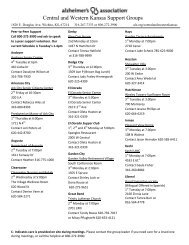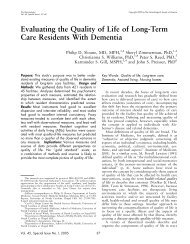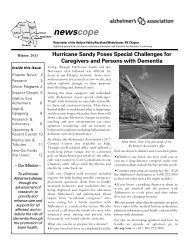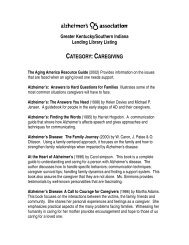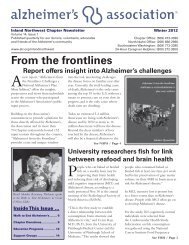First Line Treatment - Alzheimer's Association
First Line Treatment - Alzheimer's Association
First Line Treatment - Alzheimer's Association
Create successful ePaper yourself
Turn your PDF publications into a flip-book with our unique Google optimized e-Paper software.
11/25/2013<br />
Behavior plan cont.<br />
Behavior plan cont.<br />
• What percentage of the behavior do you anticipate the<br />
intervention will address<br />
• State what percentage of the remaining behavior would be<br />
acceptable (if any) and how you plan to address the remaining<br />
behavior<br />
• Indicate the date(s) when the team will meet to assess<br />
intervention outcomes and what measures (methods) will be<br />
used to assess the outcomes<br />
• Who will write the report of the intervention outcomes, enter<br />
the report into the chart, and inform all authorized parties<br />
• When will the team meet again to evaluate if the plan needs<br />
to be changed<br />
• Enter the behavior plan and outcomes into the care plan<br />
• If the intervention was determined to be unsuccessful, the<br />
team should meet to discuss why the plan failed and consider<br />
the relevance of other behavioral triggers and a new<br />
intervention strategy.<br />
*developed by Paul Raia, Ph.D., Alzheimer’s <strong>Association</strong>,<br />
Massachusetts and New Hampshire Chapter<br />
Depression<br />
• Need to recognize the different presentations of<br />
depression in the older adult.<br />
• Increase and encourage activities that the person<br />
can enjoy. Identify activities enjoyed in the past<br />
and modify as appropriate. Pleasurable activities<br />
decrease depression in dementia.<br />
• Confirm that the activities are really those that<br />
the individual enjoys. Ask the individual what<br />
they like.<br />
• Plan pleasant activities to be conducted with<br />
someone whose company the person enjoys.<br />
• Provide a bright and cheerful environment.<br />
Agitation and Aggression<br />
• Intervene early by recognizing a problem situation and<br />
attempting to intervene before it becomes a problem.<br />
• Keep the individual away from situations and<br />
individuals that are provoking.<br />
• Use a reassuring and gentle voice.<br />
• Approach slowly and calmly from the front. Tell the<br />
individual what you are doing.<br />
• Use touch judiciously – this largely depends on the<br />
person.<br />
• Use non-threatening postures (standing over a person,<br />
etc.)<br />
• Establish a calm and quiet environment.<br />
• Avoid arguing while the person is agitated – this almost<br />
Wandering<br />
• A confused person will often forget that he or<br />
she is supposed to be at a particular place and<br />
so frequent reassurance is important.<br />
• If the person is able to understand what is<br />
going on, try to involve them in the planning.<br />
With more confused individuals it may be<br />
easier not to introduce them gradually, but to<br />
make the move as quickly as possible and<br />
without any fuss.<br />
Repetitive questions/mannerisms<br />
• Caregivers often find this extremely irritating or<br />
distressing. Reasoning with the individual or<br />
confronting them, however, is generally futile.<br />
• Sometimes ignoring the repeated questions will<br />
work but I find that more often it just irritates<br />
them more.<br />
• Sometimes the person may be unable to express<br />
what is actually worrying him or her. Caregivers<br />
have the opportunity to react healthily to this<br />
emotional aspect.<br />
• Distraction can be helpful by giving a new and<br />
specific task to perform. Caregiver must not<br />
pressure the individual or sound upset.<br />
5




